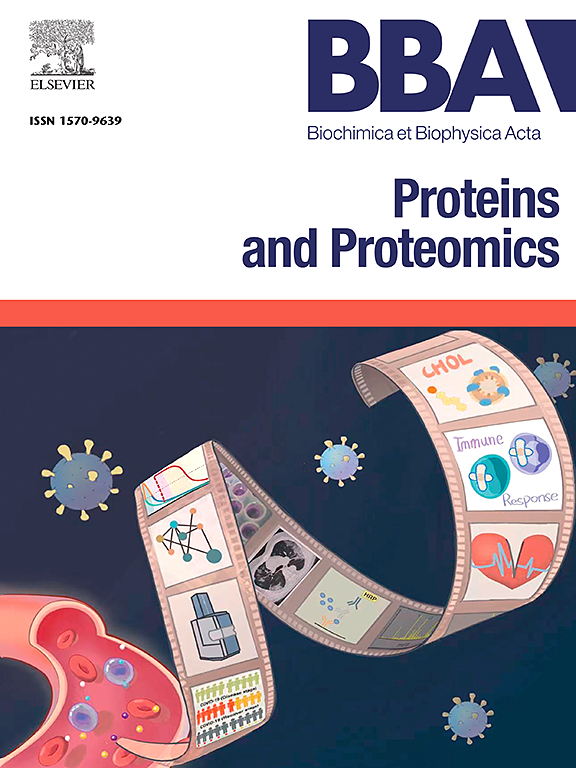Oxygen-carrying proteins employed in blood substitute candidates: differences in interactions with a model antioxidant molecule
IF 2.3
4区 生物学
Q3 BIOCHEMISTRY & MOLECULAR BIOLOGY
Biochimica et biophysica acta. Proteins and proteomics
Pub Date : 2025-06-11
DOI:10.1016/j.bbapap.2025.141086
引用次数: 0
Abstract
Glutaraldehyde-polymerized hemoglobin (poly-Hb) has long been explored as a key candidate for blood substitute compositions, to be used in transfusions in order to supplement the oxygen-carrying capacity following severe blood loss. Bovine hemoglobin (bHb) has been the standard choice for such efforts, due to its reasonable availability and to its reduced dependence on organic allosteric effectors. We have recently shown that poly-Hb produced from ovine Hb (poly-oHb) outperforms poly-bHb in in vivo tests employing transfusion after up to 30 % blood loss in animals. This improvement was found to correlate with an increased resistance of ovine hemoglobin (oHb) and of poly-oHb towards oxidative and nitrosative stress agents in vitro. The molecular bases for these differences in reactivity offer an interesting challenge, given the high sequence homology between vertebrate hemoglobins. Reported here is an investigation of these molecular bases using different spectroscopic (fluorescence, resonance Raman, NMR, EPR) and computational (molecular docking) methods to assess the interaction with a convenient probe ligand representative of the class of natural antioxidants, caffeic acid. Fluorescence experiments reveal that ovine Hb fluorescence saturates above 25 μM caffeic acid and indicating full occupancy of fluorescence-responsive binding sites, while resonance Raman and NMR data indicate signals for the heme and indicate the differences between the types of Hbs and the antioxidant binding behavior after polymerization. Computational docking corroborated the spectroscopic data by identifying aromatic residues and distinct affinity patterns for caffeate. The results show that structural differences in oHb may explain a higher redox stability.
在血液替代品候选物中使用的携氧蛋白:与模型抗氧化剂分子相互作用的差异
戊二醛聚合血红蛋白(polyhb)长期以来一直被视为血液替代成分的关键候选物,用于输血以补充严重失血后的携氧能力。牛血红蛋白(bHb)由于其合理的可用性和对有机变构效应物的依赖性降低,一直是这类工作的标准选择。我们最近的研究表明,在动物失血高达30%后输血的体内试验中,由羊血红蛋白(poly-oHb)产生的聚血红蛋白优于聚血红蛋白。这种改善被发现与羊血红蛋白(oHb)和多oHb对体外氧化和亚硝化应激剂的抗性增加有关。考虑到脊椎动物血红蛋白之间的高序列同源性,这些反应性差异的分子基础提供了一个有趣的挑战。本文报道了利用不同的光谱(荧光、共振拉曼、核磁共振、EPR)和计算(分子对接)方法对这些分子碱基进行研究,以评估它们与天然抗氧化剂——咖啡酸一类具有代表性的探针配体的相互作用。荧光实验表明,羊血红蛋白的荧光在25 μM咖啡酸以上饱和,表明荧光响应的结合位点被完全占据,而共振拉曼和核磁共振数据表明血红素的信号,表明血红素类型和聚合后抗氧化结合行为的差异。计算对接通过识别芳香残基和咖啡酸的独特亲和力模式证实了光谱数据。结果表明,oHb的结构差异可能解释了更高的氧化还原稳定性。
本文章由计算机程序翻译,如有差异,请以英文原文为准。
求助全文
约1分钟内获得全文
求助全文
来源期刊
CiteScore
8.00
自引率
0.00%
发文量
55
审稿时长
33 days
期刊介绍:
BBA Proteins and Proteomics covers protein structure conformation and dynamics; protein folding; protein-ligand interactions; enzyme mechanisms, models and kinetics; protein physical properties and spectroscopy; and proteomics and bioinformatics analyses of protein structure, protein function, or protein regulation.

 求助内容:
求助内容: 应助结果提醒方式:
应助结果提醒方式:


